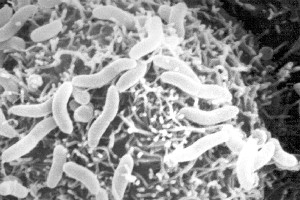Colwellia psychrerythraea neu2011: Difference between revisions
No edit summary |
No edit summary |
||
| Line 1: | Line 1: | ||
[[File:C.psychrerythraea.jpg|thumb|alt=Alt text| | [[File:C.psychrerythraea.jpg|thumb|alt=Alt text|Photo: Richard A. Finkelstein Project ID 275/NCBI]] | ||
Revision as of 20:02, 21 February 2011
Classification
Higher order taxa
Domain: Bacteria
Phylum: Proteobacteria
Class: Gammaproteobacteria
Order: Alteromonadales
Family: Colwelliaceae
Genus: Colwellia
Species: Colwellia psychrerythraea
Strain: 34H / ATCC BAA-68
Description and Significance
Colwellia psychrerythraea is a facultative anaerobe; a gram-negative bacteria that appears rod-shaped and red in pigment.[1] Its rod shape is determined by the protein MreC. It is a chemo-organotroph that requires Na+ for growth. This bacterium possesses flagella for motility in its natural habitat of the deep sea Arctic and Antarctic Ice, the coldest marine habitat on Earth. The strain 34H/ATCC BAA-681 (Vibrio psychroerythus) that was isolated from this marine habitat shows flagella present, two membranes, and no inteins. It is not pathogenic to humans.[2]
The extreme habitat that Colwellia is able to survive in makes this species unique and valuable. Since completion of its genome, Colwellia psychrerythraea 34H has become a model for the study of life in permanently cold environments, revealing capabilities important to carbon and nutrient cycling, bioremediation, production of secondary metabolites, and cold-adapted enzymes. There are suggestions that cold-adaptation throughout the entire cell, especially proteome composition, may enhance enzyme effectiveness at low temperatures. These enzymes are capable of degrading high molecular weight compounds, obtaining energy and nutrients for the cell, confirming this organism's evolutionary success and importance in environmental cycles. Adaptation rather than a unique set of genes allow Colwellia to survive in such harsh conditions. These features make Colwellia species important in carbon and nutrient cycling in the cold marine environments in which they inhabit. Observation of this organism can possibly give insight into earlier Earth environments as well as those on other planets and moons.[3]
Genome Structure
Colwellia psychrerythraea consists of a single, circular chromosome. The chromosome is made up of 5,373,180 base pairs and 5,053 genes. Of those genes, 4,397 are protein coding genes.[4] Protein structure of cold-active enzymes is still not well understood. However, this makes Colwellia a model organism for cold adaptation.[5] Further studies confirmed that Colwellia has an outer membrane and peptidoglycan layer. The peptidoglycan layer contains proteins like FtsZ and FtsA, which aid in cell division.[6]
Cell Structure and Metabolism
Ecology
Pathology
Current Research
Cool Factor
Colwellia psychrerythraea is a promising bacterium for the development of temperature-sensitive strains of vaccines. Researchers at the University of Victoria in Canada have successfully isolated several essential genes from Colwellia psychrerythraea and implanted them into the human pathogen Francisella novicida. Since the enzymes of Colwellia psychrerythraea can only function at temperatures up to 20C, this modified pathogen could then be implanted into cooler parts of the body to allow for an immune response to occur. Indeed, when Francisella novicida was implanted into the tail of labs rats, it was able to thrive locally and elicit an immune response within the rat, but was unable to spread to warmer body parts due to the temperature-sensitivity of Colwellia psychrerythraea enzymes. Upon dosing these same rats with normal Francisella novicida several weeks later, the rats remained healthy, providing evidence that temperature-sensitive vaccines could provide a useful therapy for combating a vast variety of future illnesses.
References
[1] Ivanova, et al. Phylogenetic relationships among marine Alteromonas-like proteobacteria: emended description of the family Alteromonadaceae and proposal of Pseudoalteromonadaceae fam. nov., Colwelliaceae fam. nov., Shewanellaceae fam. nov., Moritellaceae fam. nov., Ferrimonadaceae fam. nov., Idiomarinaceae fam. nov. and Psychromonadaceae fam. Nov. Int. J. Syst. Evol. Microbiol., 2004, 54, 1773-88
[2] Methe, et al. The psychrophilic lifestyle as revealed by the genome sequence of Colwellia psychrerythraea 34H through genomic and proteomic analyses. Proc. Natl. Acad. Sci. U.S.A., 2005, 102, 10913-18.
[3] Methe, et al, 10913-18.
[4] J. Craig Venter Institute. “General Information for Colwellia psychrerythraea 34H.” September, 2005. < http://cmr.jcvi.org/cgi-bin/CMR/GenomePage.cgi?org=gcw>
[5] Methe, et al, 10913-18.
[6] J. Craig Venter Institute. “Genome Properties Report. September, 2005.” <http://cmr.jcvi.org/cgi-bin/CMR/shared/GenomePropReport.cgi?prop_acc=GenProp0158&ori_db=gcw>

